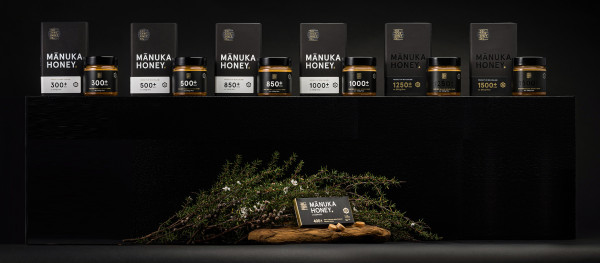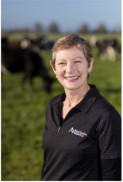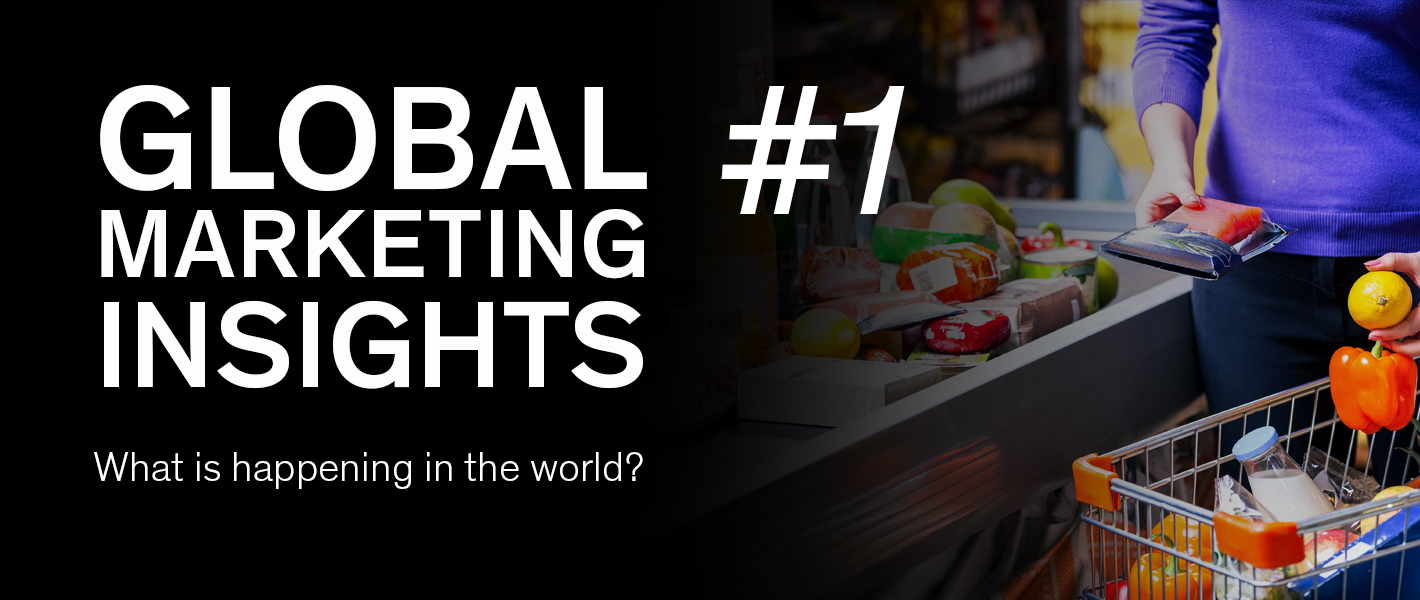Welcome to AsureQuality’s Global Food Marketing Insight Series
in Assurance Marks
Author: Kellee Henton
4197
With more than two years of insights and learnings around the China marketing calendar,(external link) we are excited to extend this series to a global scope.
As a nation of five million people, New Zealand feeds more than 40 million global consumers each year1. We export2 a lot of the food we produce as a nation, including 95% of dairy, 87% of beef, 90% of kiwifruit, 63% of commercially caught seafood, and many other categories.
With the rising export number, it is important for New Zealand brands to keep an eye on what is happening in the global food market. As a dedicated team that supports NZ products to succeed in a crowded international marketplace, AsureQuality Assurance Marks brings a summary of the latest global food marketing news to you.
China’s booming ‘She economy’
International Women’s Day is celebrated annually on March 8th and in China the month of March is becoming increasingly significant as a major shopping festival, promoting domestic consumption3 aimed at bolstering the economy. Market demand has seen a marked increase in products such as functional food, jewellery and bouquets, with both online and offline stores experiencing a surge. As per the Global Times report, SKP, one of Beijing's significant shopping malls, witnessed a noticeable spike in customer traffic on Women's Day compared to the regular weekday, with a majority of female customers. And Taobao's Women's Day campaign in 2022 garnered the attention of 70 million viewers and resulted in NZD $655 in sales4.
This presents a lucrative opportunity for businesses to capitalise on the thriving "she economy" trend4 in China, which is led by financially independent young women from the millennial and Gen-Z generations, who prioritise personal happiness over traditional societal roles. This trend has also spurred the growth of female-centric businesses catering to women's preferences and needs, making China the world's third-largest consumer market for women5. Now the market is equivalent to the combined retail markets of Germany, France, and the UK. It is a propitious moment for brands6 to acknowledge and honour women, implement equitable practices, allocate resources and time towards advancing gender parity, and ultimately augment their sales. However, it is vital to note that certain brands may fail7 to deliver the intended message and attract negative publicity.
China's marriage and birth rates have reached an all-time low8, with the birth rate plummeting to 6.77 per 1,000 people in 2022, resulting in a decline in population for the first time in six decades. This indicates that Chinese women are increasingly inclined towards self-investment in personal growth and development9. We can see growing popularity of functional foods that cater to women's health needs, including products enriched with vitamins, minerals, and essential nutrients in China's food and supplement market4. JD.com's data for 2022 also shows that women spent 1.43 times more than men on fitness and outdoor products, with a 30% YoY increase in spending on education and training-related products.
It is relevant for company brand strategies seeking inspiration for international market opportunities and growth to consider today’s changing situation for women, especially as it relates to social, nutrition & health and economic factors.
Radical options for food labelling in Australia
According to a recent meta-analysis10, food labels have been found to promote the consumption of healthier foods. However, in Australia, most food label formats do not seem to deter people from choosing unhealthy food options11.
As alcohol is high in energy but poor in nutrients, the Australian Dietary Guidelines advise people to limit their alcohol intake to manage their body weight. However, unlike other packaged drinks, alcoholic beverages are not required to display nutrition content on labels, which makes it difficult for consumers to understand the energy content of alcohol in their diet.
Dr Miranda Blake, a senior author of a study conducted by Deakin University's Global Centre for Preventive Health and Nutrition (GLOBE), pointed out that 85%12 of consumers agreed that the food industry should set higher standards for food labelling. Studies suggest that warning labels13 could be added to all products that are high in risky nutrients like sodium and sugar, among other recommendations to improve food label design in Australia. Public health organisations also recommend that food labels should include information on added sugar levels. As Dr. Black stated, reviews of studies on consumer behaviour have shown that clearer labelling of added sugars on food packaging helps some consumers choose products with lower sugar content.
To make food labels more effective, it is pointed out that more radical options should also be explored, including environmental sustainability labelling and plain packaging for unhealthy foods (similar to the packaging rules for tobacco). An important function of plain packaging is to avoid attracting kids to try unhealthy food with cartoon characters on packaging.
Last year, Food Standards Australia New Zealand (FSANZ) announced its plans to consider including energy labels on alcoholic beverages14. Although the impact of food labels may be modest, implementing such changes on a large scale can help improve people’s eating habits to be healthier.
Authenticity concerns for Mānuka honey in Europe and the US
Mānuka honey is considered a high-end product and is known for its unique antibacterial properties. New Zealand dominates the global market, with 76% of its 22,000 tonnes of honey exports15 being Mānuka honey to 40 markets worldwide. According to a report16, the market size for Mānuka honey is expected to reach USD $1,032.73 million by the end of 2028, growing at a CAGR of 7.78%.
All honey labelled as Mānuka for export from New Zealand must undergo testing by an MPI-recognised third-party laboratory to ensure it meets the Mānuka definition17. The definition consists of five attributes, including four chemicals from nectar and one DNA marker from Mānuka pollen.
However, outside of New Zealand, the standard of testing does not seem to exist. Unique Mānuka Factor Honey Association (UMFHA) has conducted tests on 46 Mānuka brands produced outside New Zealand and sold in the US and Europe, and all results failed to meet New Zealand's regulatory criteria for authentic Mānuka honey18. Another test on 40 products19 from main overseas honey markets also showed that the products cannot be categorisd as Mānuka.
In order to safeguard the authenticity of Mānuka honey, the New Zealand government has provided $2.51 million to honey producers for conducting scientific research and development. Additionally, they have also granted a loan of $1.07 million to aid the legal protection of the brand globally. Renewing of Mānuka honey trademark applications in Europe and the UK20 has also commenced to ensure that the product is not mislabelled or imitated.
The True Honey Co, a New Zealand Mānuka honey producer, also provides an example of how they protect their reputation in the global market. They partnered with Assurance Marks to demonstrate the premium attributes and supply chain transparency of their Mānuka honey products. By scanning the QR code on the box, consumers can instantly see the product’s verified AQ AssuredTM information, including the origin of the Mānuka honey, backed by the New Zealand Government.

Is the vegan Asian food market taking over the world?
The vegan Asian food market is expected to experience a significant increase in value21, with a projected worth of US$ 18,196.8 million in 2023 and a further rise to US$ 30,806.3 million by 2033. And the demand for vegan Asian food is set to rise steadily with a CAGR of 6%.
The health and wellness trend in Asia is growing, with consumers becoming more health-conscious and looking for foods low in sugar, salt, and fat. This trend is driven by the increasing prevalence of lifestyle-related diseases such as obesity and diabetes22, and consumers are seeking food products which canhelp maintain a healthy diet to avoid potential diseases.
Government backing is another key factor in the growth of the food industry in Asia23. Many governments in the region are investing in the sector and enacting policies and guidelines to enhance the safety and quality of food products, boost production, and ensure food security. These efforts have resulted in notable enhancements in food safety and quality, as well as the development of innovative technologies to cater to the evolving requirements of consumers.
China, India, and the United Kingdom are considered promising markets24 for vegan Asian cuisine, with India predicted to have a projected valuation of $669.2 million in 2022 and an anticipated CAGR of 6% from 2023 to 2033. India has a significant and expanding population, a long-standing vegetarian tradition, and a growing awareness of the health and environmental benefits of plant-based diets. Moreover, India boasts a diverse and abundant culinary heritage with a broad selection of plant-based ingredients and dishes, which can be used to produce vegan Asian food products.
That’s the key takeaways from the regions with the closest trade with New Zealand. I hope you enjoy reading them!
Meet Us at Fieldays!
Assurance Marks will be attending Fieldays at AsureQuality’s booth from 14 – 17 June in Mystery Creek Hamilton. We cordially invite you to visit us at the Fieldays, talk to industry experts, and discover first-hand how our services can help demonstrate your supply chain transparency and drive product premiums in the global market.
See you at the Fieldays!
Meet Lesley, Our Assurance Marks Quality Expert

With a passion for quality and an eye for detail, Lesley works closely with our Assurance Marks Customers as they seek to make verified claims across their supply chains.
Lesley has a background in food testing having worked in laboratories for much of her career- including a nearly 10-year stint in the AQ Auckland Laboratory prior to joining the Assurance Marks team in 2018.
Whether it be short video clips for specific events or longer more technical presentations Lesley loves bringing verified stories to life and can often be found in the front of a camera supporting our customers in their co-marketing campaigns.
Free consultation with personalised solutions
We support brands with claim substantiation, verification, and co-marketing activities demonstrating trusted assurance, and building consumer confidence and engagement.
You can book a free 15-minute consultation(external link) to discuss how to leverage AsureQuality's New Zealand Government-owned independent food assurance expertise within your marketing mix.
If you have any questions, please don't hesitate to get in touch with our team of experts.
If you’ve missed previous issues of our China Marketing Insight Series, you can find them here.(external link)
Follow our official WeChat account where you can explore more case studies, technical information, and market insights in Chinese. Just simply search our WeChat ID: AsureQuality_NZ
We look forward to sharing more with you soon!
References
- Hancock , F. (2021, June 7). Who's Eating New Zealand? Retrieved May 5, 2023, from https://www.stuff.co.nz/business/farming/300350351/whos-eating-new-zealand(external link)
- Mcilraith, B. (2023, February 24). By the Numbers: Who Is Eating All of Our Food If We Make Enough to Feed 40 Million People? Retrieved May 20, 2023, from https://www.stuff.co.nz/business/131311360/by-the-numbers-who-is-eating-all-of-our-food-if-we-make-enough-to-feed-40-million-people(external link)
- (2023, March 8). ‘She Economy’ Boosts Consumption Eecovery Amid Nation’s Strengthened Efforts. Global Times. Retrieved May 15, 2023, from https://www.globaltimes.cn/page/202303/1286925.shtml?from=timeline(external link)
- Dudarenok, A. (2023, March 7). Winning Over The ‘She Economy’: How To Tap Female Consumption In China. Jing Daily. Retrieved May 15, 2023, from https://jingdaily.com/china-she-economy-female-consumption/(external link)
- Sun , L., & He, H. (2023, March 16). China’s ‘She Economy’ Booms as Young and Financially Independent Women Spend for Themselves. Jing Daily. Retrieved May 21, 2023, from https://12ft.io/proxy?q=https%3A%2F%2Fwww.scmp.com%2Feconomy%2Fchina-economy%2Farticle%2F3170540%2Fchinas-she-economy-booms-young-and-financially-independent(external link)
- Coy, K. (2023, March 6). Even More International Women’s Day Events and Deals. The Beijinger. Retrieved May 21, 2023, from https://www.thebeijinger.com/blog/2023/03/06/even-more-international-womens-day-events-and-deals(external link)
- (2023, March 9). 'What do women taste like?' IWD Ads in China Trigger Outcry and Immediate Deletion. Marketing-Interactive. Retrieved May 21, 2023, from https://www.marketing-interactive.com/iwd-ads-in-china-triggers-outcry-and-immediate-deletion(external link)
- Ye , Z. (2022, December 2). After Falling Births, China’s Marriage Rate Sees New Low — Again. Sixth Tone. Retrieved May 25, 2023, from https://www.sixthtone.com/news/1011808(external link)
- Law, J. (2023, March 8). China’s ‘She Economy’ Booms As Women Invest In Their Own Happiness. Jing Daily. Retrieved May 25, 2023, from https://jingdaily.com/china-she-economy-female-consumer-spending-2023/(external link)
- Zlatevska, N., Barton , B., Dubelaar, C., & Hohberger, J. (2023, February 3). Navigating Through Nutrition Labeling Effects: A Second-Order Meta-Analysis. Sage Journals. Retrieved May 18, 2023, from https://journals.sagepub.com/doi/10.1177/07439156231158115(external link)
- Sacks, G., & Chan, J. (2023, February 24). Clear Nutrition Labels Can Encourage Healthier Eating Habits. Here’s How Australia’s Food Labelling Can Improve. The Conversation. Retrieved May 18, 2023, from https://theconversation.com/clear-nutrition-labels-can-encourage-healthier-eating-habits-heres-how-australias-food-labelling-can-improve-200336(external link)
- (2013, February 28). Australian Dietary Guidelines. Eat For Health. Retrieved May 19, 2023, from https://www.eatforhealth.gov.au/sites/default/files/2022-09/n55_australian_dietary_guidelines.pdf(external link)
- Roberto, C. A., Ng, S. W., Ganderats-Fuentes, M., Hammond, D., Barquera, S., Jauregui, A., & Taillie, L. S. (2021, August 2). The Influence of Front-of-Package Nutrition Labeling on Consumer Behavior and Product Reformulation. Annual Reviews. Retrieved May 2, 2023, from https://www.annualreviews.org/doi/10.1146/annurev-nutr-111120-094932(external link)
- Iaria, M. (2022, May 2). Food Standards Australia New Zealand considers nutrition labels for alcohol. The West Australian. Retrieved May 2, 2023, from https://thewest.com.au/lifestyle/food-standards-australia-new-zealand-considers-nutrition-labels-for-alcohol-c-6652758(external link)
- Honey Export Data. Ministry for Primary Industries New Zealand. Retrieved April 25, 2023, from https://mpi.govt.nz/(external link)
- Gupta, S. (n.d.). Manuka Honey Market Research Report Information. Market Research Future. Retrieved April 25, 2023, from https://www.marketresearchfuture.com/reports/manuka-honey-market-3112(external link)
- Milne, J. (2021, October 21). Multi-million Dollar Mānuka Honey Industry Faces Mandatory Tests. News Room. Retrieved April 24, 2023, from https://www.newsroom.co.nz/multi-million-dollar-manuka-industry-faces-mandatory-tests(external link)
- Southey, F. (2023, March 1). Manuka Honey Claims Dismissed in US and US: 'All Non-NZ Brands Failed The Test'. Food Navigator. Retrieved April 22, 2023, from https://www.foodnavigator.com/Article/2023/03/01/manuka-honey-claims-dismissed-in-uk-and-us-all-non-nz-brands-failed-the-test?utm_source=copyright&utm_medium=OnSite&utm_campaign=copyright(external link)
- Milne , J. (2023, February 3). Inferior Overseas Honey Being Passed off as Mānuka – New Research. Food Navigator. Retrieved April 22, 2023, from https://www.newsroom.co.nz/inferior-overseas-honey-being-passed-off-as-manuka-new-research(external link)
- Murphy, S. (2023, January 24). New Zealand Mānuka Honey Producers Vow to Continue Trademark Fight. RNZ. Retrieved April 19, 2023, from https://www.rnz.co.nz/news/country/482988/new-zealand-manuka-honey-producers-vow-to-continue-trademark-fight(external link)
- Murphy, S. (n.d.). Vegan Asia Food Market from East to West: How the Vegan Asian Food Market is Taking over the World. Future Market Insights. Retrieved April 19, 2023, from https://www.futuremarketinsights.com/reports/vegan-asian-food-market(external link)
- Caruana, C. (2018, December 14). Lifestyle diseases swamp Asia’s healthcare systems. Sci Dev Net. Retrieved April 22, 2023, from https://www.scidev.net/asia-pacific/news/lifestyle-diseases-swamp-asia-s-healthcare-systems/(external link)
- (2023, March 2). Health and Wellness Trend Fuels Growth in the Vegan Asian Food Market, Propelling to Reach a Valuation of US$ 30,806 million by the year 2033: Future Market Insights, Inc. Report. Future Market Insights. Retrieved April 22, 2023, from https://finance.yahoo.com/news/health-wellness-trend-fuels-growth-113000025.html(external link)
- (2023, February 15). From East to West: How the Vegan Asian Food Market is Taking over the World. Asia Food Journal. Retrieved April 27, 2023, from https://asiafoodjournal.com/vegan-asian-food-market-taking-over-world/
